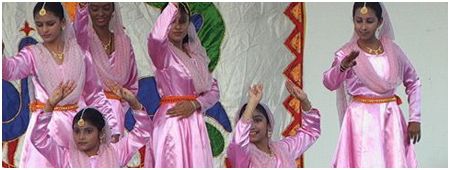Art & Culture of India

India's culture is marked by a high degree of syncretism and cultural pluralism. India's cultural tradition dates back to 8,000 BCE and has a continuously recorded history for over 2,500 years. With its roots based in the Indus Valley Tradition, the Indian culture took a distinctive shape during the 11th century BCE Vedic age which laid the foundation of Hindu philosophy, mythology, literary tradition and beliefs and practices, such as dhárma, kárma, yóga and moksa. It has managed to preserve established traditions while absorbing new customs, traditions, and ideas from invaders and immigrants and spreading its cultural influence to other parts of Asia, mainly South East and East Asia.
Indian religions form one of the most defining aspects of Indian culture. Major dhármic religions which were founded in India include Hinduism, Buddhism and Jainism. Considered to be a successor to the ancient Vedic religion, Hinduism has been shaped by several schools of thoughts such as the Advaita Vedanta, the Yoga Sutras and the Bhakti movement. Buddhism originated in India in 5th century BCE and prominent early Buddhist schools, such as Theravada and Mahayana, gained dominance during the Maurya Empire. Though Buddhism entered a period of gradual decline in India 5th century CE onwards, it played an influential role in shaping Indian philosophy and thought.
Many Indian festivals are religious in origin, although several are celebrated irrespective of caste and creed. Some popular festivals are Diwali, Ganesh Chaturthi, Ugadi, Thai Pongal, Holi, Onam, Vijayadashami, Durga Puja, Eid ul-Fitr, Bakr-Id, Christmas, Buddha Jayanti and Vaisakhi. India has three national holidays which are observed in all states and union territories - Republic Day, Independence Day and Gandhi Jayanthi. Other sets of holidays, varying between nine and twelve, are officially observed in individual states. Religious practices are an integral part of everyday life and are a very public affair.
Indian dance too has diverse folk and classical forms. Among the well-known folk dances are the bhangra of the Punjab, the bihu of Assam, the chhau of West Bengal, Jharkhand , sambalpuri of Orissa , the ghoomar of Rajasthan and the Lawani of Maharashtra. Eight dance forms, many with narrative forms and mythological elements, have been accorded classical dance status by India's National Academy of Music, Dance, and Drama. These are: bharatanatyam of the state of Tamil Nadu, kathak of Uttar Pradesh, kathakali and mohiniyattam of Kerala, kuchipudi of Andhra Pradesh, manipuri of Manipur, odissi of Orissa and the sattriya of Assam.